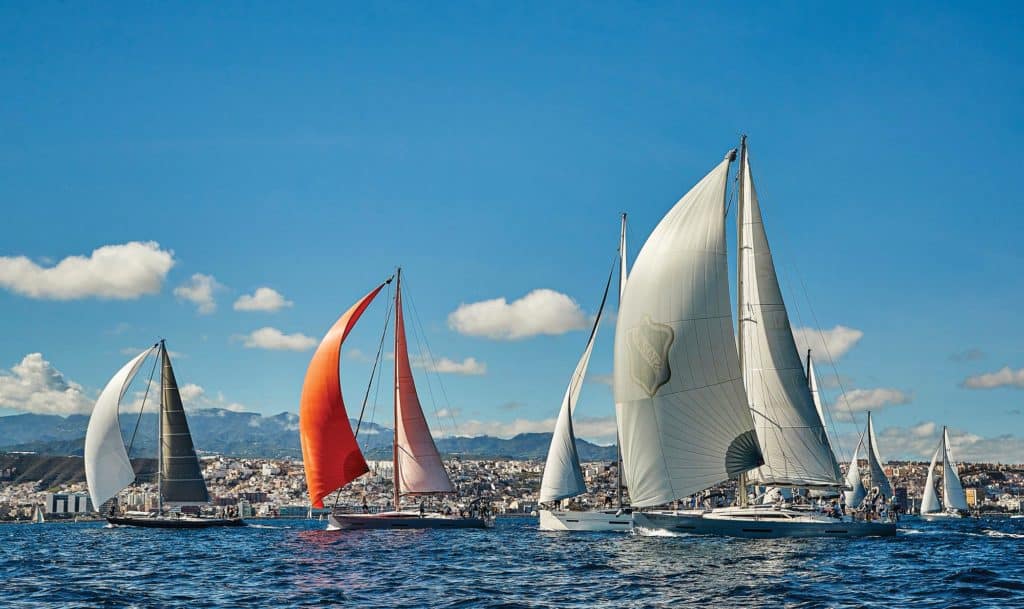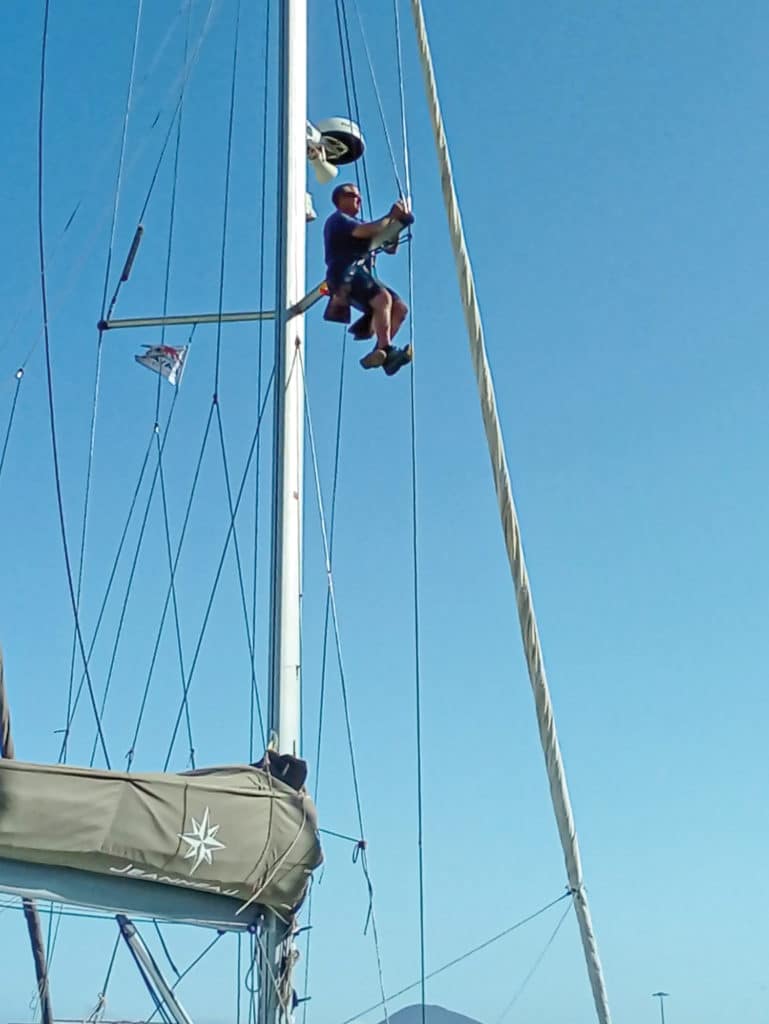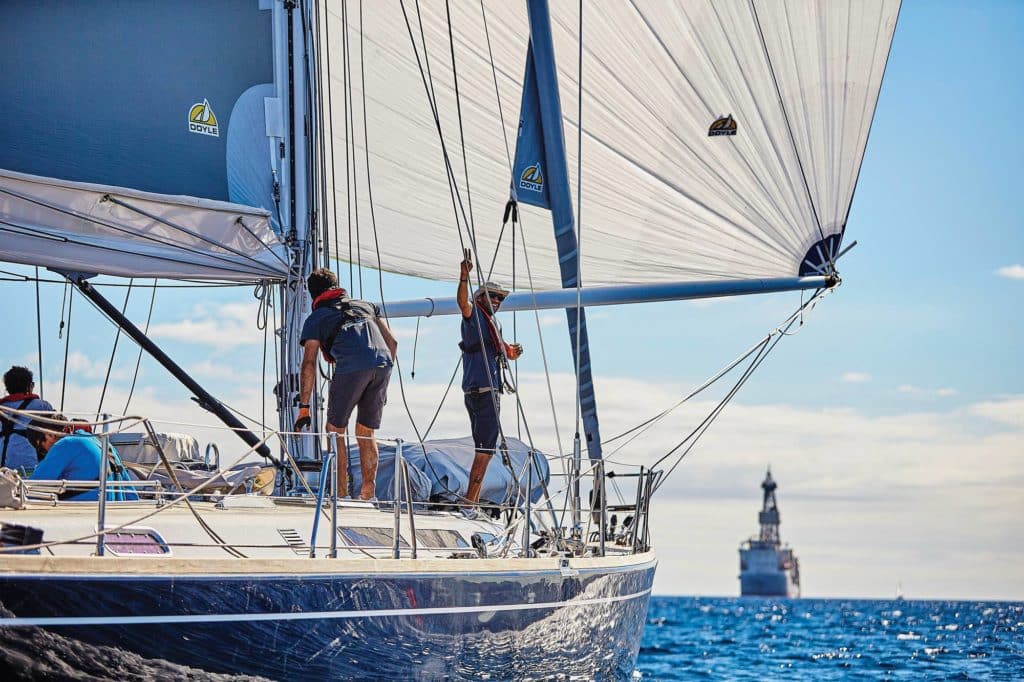
Clive Strickett is a rugged guy, so it takes strong arms to winch him aloft to the masthead. But that’s exactly where you want him: eyeball to halyard sheave, looking for problems. He’s a veteran rigger with a keen eye and a background in ocean racing on the competitive Maxi circuit. On the island of Lanzarote, where I first encountered Strickett, he has a reputation for detail.
We were on the dock at Marina Lanzarote in a fresh breeze of about 20 knots. It was sunny and warm, the sort of weather you’d expect when you’re about 400 nautical miles off the coast of Morocco. These Canary Islands, of which Lanzarote is the farthest north, are a staging area for boats embarking on a trans-Atlantic crossing.
Strickett had just been lowered to the deck of a Bavaria 41 by the boat’s skipper after checking the spreaders, and was now shaking his head. Problems. There are always problems. This time it was mismatched metals. “It’s rare to find a boat that has nothing wrong with it,” he said.
Never mind the Atlantic—the first leg of the trip from the United Kingdom and Europe to the Canaries can be brutal on gear. And that’s before the 3,800-nautical-mile downwind crossing to the Caribbean. It’s wise to have a guy like Strickett check your rig before you leave. “I’ve been doing this for a few years now,” he said. “I might see a problem that the owner missed. They weren’t looking for it, or weren’t looking where they should have been.
“You never know what’s going to happen on boats. Even on new boats,” he continued. “A friend of mine had a new catamaran, a big one, with a carbon-fiber mast. One of the genoa clutches ripped right off the mast. Brand new boat, right from the factory. We had to get the OK from the factory in France to make a repair. We fixed it, and he crossed the Atlantic.”
Minor rig problems compound quickly under pressure. Strong winds funneling through these volcanic islands can mimic trade-wind sailing, but that doesn’t mean that every boat is ready for the crossing. According to Strickett, safety lies in the details, and he points out where to look for potential problems in your rig. Here’s what Strickett is looking for as he inspects a spar, from top to bottom.
Masthead: “Be sure the sheave axles are secure. Sometimes the holes elongate or even crack. And then halyards can get mixed up. One boat that came through here from Tenerife was using the wrong halyard. They were using the spinnaker halyard instead of the genoa halyard. When I went up to look at it, the sheave box was completely gone; the rivets were all loose. The holes had elongated because the halyard was at the wrong angle. They didn’t even realize it. It’s tough to see what’s happening aloft when you’re on deck.”

Working down the mast on a fractional rig, there might be additional sheave boxes fitted for internal halyards. “Make sure all the rivets are tight. Anything fitted with bolts or rivets should be double-checked.”
Spreaders: “Inspect the spreader tips; make sure they’re OK and there’s no corrosion. Whenever you get stainless steel and aluminum together, there’s corrosion. One fleet of charter boats here had put 8 mm stainless bolts into the aluminum spreaders with no protection. Now the spreaders are corroding—the holes get bigger and bigger. But not only that, the spreader was already weakened by putting big holes in it to begin with.”
Shrouds: Broken or damaged wire rigging is the most common problem. “Most cruising boats use 1-by-19 stainless wire. Inside, one strand can let go, then another. When you get up to four broken strands, the wire gets weaker and weaker, and eventually fails. If you’re underway and that happens, then you have a big problem.”
You also don’t want extra weight aloft. “Some people use Dyform, or compacted wire, which uses triangular-shaped strands around a core. If you compare a 10 mm Dyform wire to a 10 mm 1-by-19 wire, the Dyform is stronger. I once changed a 12 mm 1-by-19 wire to a 10 mm Dyform wire. It’s the same strength, but I saved some weight aloft.
“You can’t take anything for granted,” he continued. “There was a boat getting ready to head to the Mediterranean from here, which is a long slog to windward. He was all ready to go. Just as an afterthought, the owner had me look over the rig. Good thing. I found some broken wires in the forestay. The whole mast could have come down. So have a close inspection just to make sure there are no broken wires, and that the terminals don’t have any cracks in them.”
Boom: “Once again, closely inspect the rivets. Loose padeyes on the boom get looser and can easily rip right out. The same goes for the gooseneck fittings. Check every bolt, every rivet for the slightest elongation of the holes or any loose rivets. I can’t emphasize that enough. The padeye is usually secured to the boom with 5 mm Monel rivets, but those can pull loose after a sharp pull like a jibe. They can get yanked right out of the boom. Then what? As insurance, I usually remove the 5 mm rivets and replace them with 6.3 mm rivets, which are the largest you can use. If you’ve had a big jibe and the boom hits a V1 (lower shroud), it might break or bend the boom. We fix booms at our engineering shop. They’ll straighten it, put a patch on, weld it and then paint it. That makes it strong enough. New booms delivered to Lanzarote come from France, and the delivery fee alone can cost up to $3,500.”
Read More: Check your Boat’s Rig
Turnbuckles: “Some people don’t like to tape turnbuckles; they like to see what’s going on with them. Fair enough. I wouldn’t tape it all the way closed though. Just a little tape around the split pins so that they don’t grab a sail or your ankle. On one boat that I inspected, the guy had taped up the whole thing. When we untaped it, it was all manky, which means pretty disgusting. The dirt will always get in somehow. If it’s all taped up like that, you can’t oil or lubricate it. I tell people: Now and then, service your turnbuckles. Take some turns off the turnbuckle. Make sure it’s clean and then put a little Teflon gel on it, or some MolyKote grease. Then tighten it back up.
“When you haven’t done it for some years,” he added, “they seize up and you can’t undo them. Especially a small turnbuckle. They’re chrome-plated over bronze, and when you put a big spanner in there and turn it, it’ll snap. And what you don’t want is for a wire to snap when it’s under load. It’s just preventive maintenance. Do it every six months. It takes only a couple of hours.”

Headsail Furlers: “On some ProFurl furlers, there are four black bolts that go into the furler: two that hold the cage on and two that hold the plate. On the older ones, the bolts are made of titanium, and they seize into the aluminum. I don’t know how many I have had to drill out. But you have to drill them out properly. If it’s a 6 mm bolt, first you drill straight down the middle of the hole with a 3 mm drill, then with a 4 mm, then a 5 mm, then a 5.5 mm. Hopefully it will come out with the heat and friction. ‘Easy-out’ [screw extractors] don’t work. These things are seized together. Even heat doesn’t work.”
Chain Plates: “I inspected one boat with the chain plates so loose, they were actually moving. You could see where they had scratched the paint around the hull. Down below, look carefully at the chain plates. Make sure there’s no cracking in the hull, no movement on the bolts. You can see where a bolt has bent a little, or if it’s been pulled up or down. You’ll see little scratch marks on the hull or the bulkhead.”
Mast Step: “There’s a fine balance between the shrouds being too tight and too loose. There was a good-size catamaran that left here and got into some rough seas, rolling around. The shrouds were too loose, and on one roll, the mast jumped right out of its mast step. It was just for a moment, but in that moment, the mast went overboard.”
With the inspection on the Bavaria completed, as we walked up the gangway toward the marina office, I had one last question: “If something breaks underway, can a rigger or a boatyard be held responsible?”
Strickett answered, “Sometimes. We have a basic form that says something like: ‘Rig checked. All found to be in good condition at the time of inspection.’ And I sign it. So as far as I’m concerned, everything was OK when I signed it. But if along the way, say it blows up to 40 knots and the crew still has their spinnaker up and the mast comes down, well, they might try to come back to us. So in my opinion, it boils down to this: If you’re not up to sailing the boat, then you shouldn’t be there. You just never know what’s going to happen.”
David Bond, a regular contributor to CW, is a writer, teacher and cruising sailor currently based in Germany.








